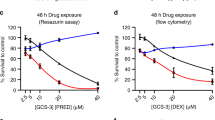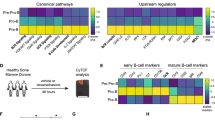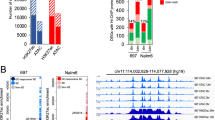Abstract
Early reduction of leukaemic cells by chemotherapy is a strong predictor for treatment outcome in childhood acute lymphoblastic leukaemia (ALL). In ALL–(Berlin–Frankfurt–Münster) trials, early treatment response is assessed by the in vivo response to glucocorticoids (prednisone response, PR), the molecular background of which is unknown. The intracellular effects of glucocorticoids (GCs) are mediated by the glucocorticoid receptor (GR). In the absence of GC, the inactive GR resides within a multiprotein complex, consisting predominantly of the chaperone protein hsp90 (heat-shock protein 90). Until now, studies targeting GC resistance mainly focused on GR disorders and alterations of genes known to be associated with drug resistance. In addition, the GR multiprotein complex was associated with GC resistance in in vitro studies. We performed a case–control study for PR to investigate the association of in vivo GC resistance and hsp90 expression in childhood ALL. Hsp90 expression was assessed using a real-time PCR approach (Taqman technology) and Western blot technology. In this setting, we found no association of in vivo GC resistance and hsp90 expression. Therefore, we conclude that the expression of hsp90, the major component of the GR activating complex, is of minor importance for the in vivo GC resistance in childhood ALL.
This is a preview of subscription content, access via your institution
Access options
Subscribe to this journal
Receive 12 print issues and online access
$259.00 per year
only $21.58 per issue
Buy this article
- Purchase on Springer Link
- Instant access to full article PDF
Prices may be subject to local taxes which are calculated during checkout



Similar content being viewed by others
References
Vilmer E, Suciu S, Ferster A, Bertrand Y, Cave H, Thyss A et al. Long-term results of three randomized trials (58831, 58832, 58881) in childhood acute lymphoblastic leukemia: a CLCG-EORTC report. Children Leukemia Cooperative Group. Leukemia 2000; 14: 2257–2266.
Schrappe M, Reiter A, Zimmermann M, Harbott J, Ludwig WD, Henze G et al. Long-term results of four consecutive trials in childhood ALL performed by the ALL-BFM study group from 1981 to 1995. Berlin– Frankfurt–Munster. Leukemia 2000; 14: 2205–2222.
Riehm H, Reiter A, Schrappe M, Berthold F, Dopfer R, Gerein V et al. Corticosteroid-dependent reduction of leukocyte count in blood as a prognostic factor in acute lymphoblastic leukemia in childhood (therapy study ALL-BFM 83). Klin Padiatr 1987; 199: 151–160.
Reiter A, Schrappe M, Ludwig WD, Hiddemann W, Sauter S, Henze G et al. Chemotherapy in 998 unselected childhood acute lymphoblastic leukemia patients. Results and conclusions of the multicenter trial ALL-BFM 86. Blood 1994; 84: 3122–3133.
Dordelmann M, Reiter A, Borkhardt A, Ludwig WD, Gotz N, Viehmann S et al. Prednisone response is the strongest predictor of treatment outcome in infant acute lymphoblastic leukemia. Blood 1999; 94: 1209–1217.
Schrappe M, Reiter A, Ludwig W-D, Harbott J, Zimmermann M, Hiddemann W et al. Improved outcome in childhood acute lymphoblastic leukemia despite reduced use of anthracyclines and cranial radiotherapy: results of trial ALL-BFM 90. German–Austrian–Swiss ALL-BFM Study Group. Blood 2000; 95: 3310–3322.
Gajjar A, Ribeiro R, Hancock ML, Rivera GK, Mahmoud H, Sandlund JT et al. Persistence of circulating blasts after 1 week of multiagent chemotherapy confers a poor prognosis in childhood acute lymphoblastic leukemia. Blood 1995; 86: 1292–1295.
Steinherz PG, Gaynon PS, Breneman JC, Cherlow JM, Grossman NJ, Kersey JH et al. Cytoreduction and prognosis in acute lymphoblastic leukemia – the importance of early marrow response: report from the Childrens Cancer Group. J Clin Oncol 1996; 14: 389–398.
Chessells JM, Bailey C, Richards SM . Intensification of treatment and survival in all children with lymphoblastic leukaemia: results of UK Medical Research Council trial UKALL X. Lancet 1995; 345: 143–148.
Thyss A, Suciu S, Bertrand Y, Mazingue F, Robert A, Vilmer E et al. Systemic effect of intrathecal methotrexate during the initial phase of treatment of childhood acute lymphoblastic leukemia. The European Organization for Research and Treatment of Cancer Children's Leukemia Cooperative Group. J Clin Oncol 1997; 15: 1824–1830.
Yudt MR, Cidlowski JA . The glucocorticoid receptor: coding a diversity of proteins and responses through a single gene. Mol Endocrinol 2002; 16: 1719–1726.
Morishima Y, Murphy PJ, Li DP, Sanchez ER, Pratt WB . Stepwise assembly of a glucocorticoid receptor.hsp90 heterocomplex resolves two sequential ATP-dependent events involving first hsp70 and then hsp90 in opening of the steroid binding pocket. J Biol Chem 2000; 275: 18054–18060.
Tsai SY, Carlstedt-Duke J, Weigel NL, Dahlman K, Gustafsson JA, Tsai MJ, O'Malley BW . Molecular interactions of steroid hormone receptor with its enhancer element: evidence for receptor dimer formation. Cell 1988; 55: 361–369.
Geley S, Fiegl M, Hartmann BL, Kofler R . Genes mediating glucocorticoid effects and mechanisms of their regulation. Rev Physiol Biochem Pharmacol 1996; 128: 1–97.
Baxter JD . Advances in glucocorticoid therapy. Adv Intern Med 2000; 45: 317–349.
Chapman MS, Askew DJ, Kuscuoglu U, Miesfeld RL . Transcriptional control of steroid-regulated apoptosis in murine thymoma cells. Mol Endocrinol 1996; 10: 967–978.
Kofler R . The molecular basis of glucocorticoid-induced apoptosis of lymphoblastic leukemia cells. Histochem Cell Biol 2000; 114: 1–7.
Pui CH, Costlow ME, Kalwinsky DK, Dahl GV . Glucocorticoid receptors in childhood acute non-lymphocytic leukemia. Leuk Res 1983; 7: 11–16.
Sousa AR, Lane SJ, Cidlowski JA, Staynov DZ, Lee TH . Glucocorticoid resistance in asthma is associated with elevated in vivo expression of the glucocorticoid receptor beta-isoform. J Allergy Clin Immunol 2000; 105: 943–950.
Shahidi H, Vottero A, Stratakis CA, Taymans SE, Karl M, Longui CA et al. Imbalanced expression of the glucocorticoid receptor isoforms in cultured lymphocytes from a patient with systemic glucocorticoid resistance and chronic lymphocytic leukemia. Biochem Biophys Res Commun 1999; 254: 559–565.
Koper JW, Stolk RP, de Lange P, Huizenga NA, Molijn GJ, Pols HA, Grobbee DE, Karl M, de Jong FH, Brinkmann AO, Lamberts SW . Lack of association between five polymorphisms in the human glucocorticoid receptor gene and glucocorticoid resistance. Hum Genet 1997; 99: 663–668.
Anderer G, Schrappe M, Brechlin AM, Lauten M, Muti P, Welte K, Stanulla M . Polymorphisms within glutathione S-transferase genes and initial response to glucocorticoids in childhood acute lymphoblastic leukaemia. Pharmacogenetics 2000; 10: 715–726.
Lauten M, Matthias T, Stanulla M, Beger C, Welte K, Schrappe M . Association of initial response to prednisone treatment in childhood acute lymphoblastic leukaemia and polymorphisms within the tumour necrosis factor and the interleukin-10 genes. Leukemia 2002; 16: 1437–1442.
Kojika S, Sugita K, Inukai T, Saito M, Iijima K, Tezuka T et al. Mechanisms of glucocorticoid resistance in human leukemic cells: implication of abnormal 90 and 70 kDa heat shock proteins. Leukemia 1996; 10: 994–999.
Dittmar KD, Demady DR, Stancato LF, Krishna P, Pratt WB . Folding of the glucocorticoid receptor by the heat shock protein (hsp) 90-based chaperone machinery. The role of p23 is to stabilize receptor.hsp90 heterocomplexes formed by hsp90.p60.hsp70. J Biol Chem 1997; 272: 21213–21220.
Bahr MJ, Vincent KJ, Arthur MJ, Fowler AV, Smart DE, Wright MC et al. Control of the tissue inhibitor of metalloproteinases-1 promoter in culture-activated rat hepatic stellate cells: regulation by activator protein-1 DNA binding proteins. Hepatology 1999; 29: 839–848.
Yufu Y, Nishimura J, Nawata H . High constitutive expression of heat shock protein 90 alpha in human acute leukemia cells. Leuk Res 1992; 16: 597–605.
Chant ID, Rose PE, Morris AG . Analysis of heat-shock protein expression in myeloid leukaemia cells by flow cytometry. Br J Haematol 1995; 90: 163–168.
Rajapandi T, Greene LE, Eisenberg E . The molecular chaperones Hsp90 and Hsc70 are both necessary and sufficient to activate hormone binding by glucocorticoid receptor. J Biol Chem 2000; 275: 22597–22604.
Pratt WB . The role of heat shock proteins in regulating the function, folding, and trafficking of the glucocorticoid receptor. J Biol Chem 1993; 268: 21455–21458.
Prima V, Depoix C, Masselot B, Formstecher P, Lefebvre P . Alteration of the glucocorticoid receptor subcellular localization by non steroidal compounds. J Steroid Biochem Mol Biol 2000; 72: 1–12.
Miyata Y, Yahara I . Cytoplasmic 8 S glucocorticoid receptor binds to actin filaments through the 90-kDa heat shock protein moiety. J Biol Chem 1991; 266: 8779–8783.
Bray PJ, Du B, Mejia VM, Hao SC, Deutsch E, Fu C et al. Glucocorticoid resistance caused by reduced expression of the glucocorticoid receptor in cells from human vascular lesions. Arterioscler Thromb Vasc Biol 1999; 19: 1180–1189.
Blagosklonny MV, Fojo T, Bhalla KN, Kim JS, Trepel JB, Figg WD et al. The Hsp90 inhibitor geldanamycin selectively sensitizes Bcr–Abl-expressing leukemia cells to cytotoxic chemotherapy. Leukemia 2001; 15: 1537–1543.
Oehrl W, Kardinal C, Ruf S, Adermann K, Groffen J, Feng GS et al. The germinal center kinase (GCK)-related protein kinases HPK1 and KHS are candidates for highly selective signal transducers of Crk family adapter proteins. Oncogene 1998; 17: 1893–1901.
Acknowledgements
This study was partly supported by the Deutsche Leukämie Forschungshilfe, Bonn, Germany. We gratefully acknowledge the excellent cooperation of all participants of trials ALL-BFM 90 and ALL-BFM 95 as well that of all doctors and nurses at the participating medical centres.
Author information
Authors and Affiliations
Rights and permissions
About this article
Cite this article
Lauten, M., Beger, C., Gerdes, K. et al. Expression of heat-shock protein 90 in glucocorticoid-sensitive and -resistant childhood acute lymphoblastic leukaemia. Leukemia 17, 1551–1556 (2003). https://doi.org/10.1038/sj.leu.2403027
Published:
Issue Date:
DOI: https://doi.org/10.1038/sj.leu.2403027
Keywords
This article is cited by
-
Associations of HSP90AA2 gene polymorphisms with disease susceptibility, glucocorticoids efficacy and health-related quality of life in Chinese systemic lupus erythematosus patients
Genes & Genomics (2018)
-
Hsp90 inhibitor BIIB021 enhances triptolide-induced apoptosis of human T-cell acute lymphoblastic leukemia cells in vitro mainly by disrupting p53-MDM2 balance
Acta Pharmacologica Sinica (2013)
-
Effect of heat shock protein-90 (HSP90) and vascular endothelial growth factor (VEGF) on survival in acute lymphoblastic leukemia: an immunohistochemical study
Medical Oncology (2011)
-
Long-term results of five consecutive trials in childhood acute lymphoblastic leukemia performed by the ALL-BFM study group from 1981 to 2000
Leukemia (2010)
-
Unsupervised proteome analysis of human leukaemia cells identifies the Valosin-containing protein as a putative marker for glucocorticoid resistance
Leukemia (2006)



